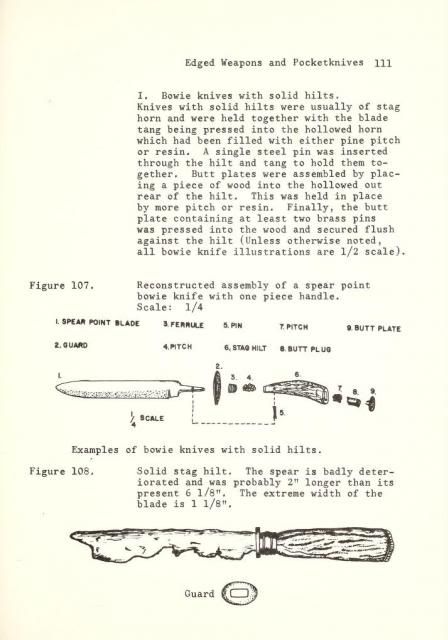crockett said:
On another forum there is a find of a British ship that sunk off of Carolina during the Civil War. Both pocket knives and Bowie knives were recovered. What caught my eye was the construction on the Bowies. These were disasembled parts. This type Bowie had a stick tang and an Antler handle. Apparently the hole through the handle was larger than the diameter of the stick tang and there were inserts at either end of the antler. These inserts or collars fit tightly around the tang and antler handle- centering the tang in the hole and holding everything tight. (Note- I just use epoxy putty to fill in the gaps but thought cutler rosin was used historically)
So....you had the blade, then a guard, then a front insert into the antler handle, a ferrule that fit around the front outside of the antler, then the antler handle, then a rear insert into the antler handle, then a cap piece on the end and a nut over the end of the tang.
I was unaware of this set up. Anyone else know anything?
Crockett I followed the info you gave me and have looked at the information on the shipwreck and recovery of the items. I am not sure if the forum will allow me to post the following links and info but I will try!
http://archive.org/stream/blockaderunnermo00brig#page/n1/mode/1up
You have got to look at the info this way. There is no telling how much of the real knife was still there after it was recovered from the wreck of the blockade runner,"Modern Greece". If the bottom picture is the true state it was in and they pulled it apart to figure out it's assembly, then they probably got it right!
So assuming they got it right about the construction/reconstruction! This would be my take on the knife's construction.
This is a
partial stick tang and at best would have not made a very good knife. For those that don't understand the terminology the tang of a knife is usually the part considered by most to be the handle. The tang is the part of the metal that extends from the blade into the handle.
Here is a link to Wikipedia that explains more of what I am talking about!
http://en.wikipedia.org/wiki/Tang_(weaponry)
A
partial tang knife such as this one recovered from the wreck would have not been nearly as strong as a
through tang knife. A through tang knife is just what the name implies, the tang extends either all the way through the handle, or nearly through. It is usually then either capped or brad-ed out, often over a washer, or the tail of the tang is threaded and capped with a metal butt piece!
The Bowie knife assembly, with only a partial tang, such as they recovered from the shipwreck would have been a cheaper answer to making a knife and more than likely would not have held up well!
However I must admit that I had no idea that this process was being used back then as this to me is more something you would see come off an assembly line!
I have looked at the info on the site briefly and I am going back again to see if I can see where these knives originated from! This now has my curosity up as too who was making these knives. Whom ever it was, was trying for quantity not quality in my opinion! However during the Civil War the South was desperate for supplies and would have been willing to buy pretty much whatever they could lay there hands on!






